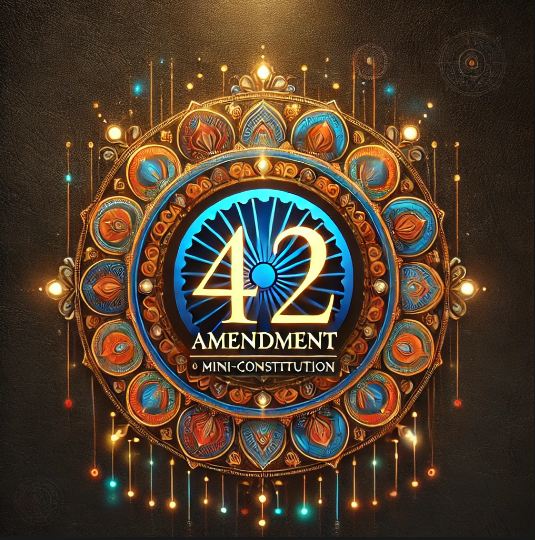The 42nd Amendment to the Indian Constitution, enacted in 1976, is often referred to as a “revision” of the Constitution due to its sweeping and transformative impact. Introduced during the Emergency period (1975-77) by the government of Prime Minister Indira Gandhi, the amendment was a landmark event in India’s constitutional history. It sought to strengthen the central government, redefine the balance between fundamental rights and directive principles, and introduce significant changes in various aspects of governance.
This amendment was so extensive in scope that it is often called the “Mini-Constitution.” Its provisions touched almost every part of the Constitution, fundamentally altering its structure, philosophy, and working. Below is a detailed analysis of why the 42nd Amendment is considered a constitutional revision.
Historical Context of the 42nd Amendment
The 42nd Amendment was introduced during the Emergency period (1975-77), a time when civil liberties were suspended, and the political landscape of India was marked by authoritarian tendencies. The ruling Congress Party, led by Indira Gandhi, had faced criticism and challenges to its governance, including judgments by the judiciary that curtailed the government’s authority.
The government sought to consolidate its power and curtail judicial activism, which it viewed as obstructing its policies. The 42nd Amendment emerged as an instrument to:
- Strengthen the executive.
- Minimize judicial intervention.
- Reflect a socialist and secular ideology in the Constitution.
- Centralize power and reduce state autonomy.
Key Features of the 42nd Amendment
The 42nd Amendment introduced changes to 59 Articles of the Constitution, added 14 new Articles, and made changes to the Preamble and Seventh Schedule. Its key features were:
- Changes to the Preamble
- The amendment added the words “Socialist,” “Secular,” and “Integrity” to the Preamble.
- The revised Preamble emphasized a stronger commitment to socialism and secularism, reflecting the government’s ideological stance.
- Strengthening the Directive Principles
- The amendment elevated the status of Directive Principles of State Policy (Part IV) over Fundamental Rights (Part III).
- It made it explicit that laws implementing Directive Principles could not be challenged on the grounds of violating Fundamental Rights.
- Judicial Curtailment
- Limited the power of judicial review by stating that constitutional amendments could not be questioned in any court.
- Introduced Articles 323A and 323B to establish administrative tribunals and restrict the judiciary’s role in such matters.
- Centralization of Power
- Strengthened the role of the central government at the expense of state governments.
- Changes to the Seventh Schedule reduced the legislative power of states.
- Extension of Parliament and State Legislatures’ Tenure
- Increased the normal term of Lok Sabha and State Legislative Assemblies from five to six years.
- Increased the normal term of Lok Sabha and State Legislative Assemblies from five to six years.
- Emergency Provisions
- Made it easier to impose President’s Rule in states and centralize power during emergencies.
- Amended Article 74 to make the President bound by the advice of the Council of Ministers.
- Introduction of Fundamental Duties
- Inserted Article 51A, enumerating Fundamental Duties for citizens.
- These duties were aimed at fostering national unity, environmental conservation, and adherence to constitutional ideals.
Why is it Called a “Revision”?
The 42nd Amendment is called a revision because of the following reasons:
- Scale and Scope of Changes
The amendment was unprecedented in its scale, affecting a large number of constitutional provisions. It not only modified existing provisions but also introduced entirely new concepts and structures, fundamentally altering the Constitution’s character. - Shift in Constitutional Philosophy
- By prioritizing Directive Principles over Fundamental Rights, the amendment shifted the Constitution’s emphasis from individual rights to collective welfare.
- The addition of “Socialist” and “Secular” to the Preamble reflected a move toward ideological governance.
- Curtailment of Judiciary
The amendment significantly restricted the judiciary’s role, undermining its independence. This was a fundamental departure from the original vision of the Constitution, which emphasized checks and balances between the three branches of government. - Centralization of Power
The 42nd Amendment undermined the federal structure by concentrating more powers in the hands of the central government. It was seen as an attempt to establish a unitary system, deviating from the Constitution’s federal spirit. - Tenure Extension and Executive Dominance
The extension of the tenure of legislatures was perceived as an undemocratic move, designed to serve the interests of the ruling party. The binding nature of the Council of Ministers’ advice further weakened the President’s independent role. - Transformative Nature
The changes introduced by the 42nd Amendment were so comprehensive that they altered the Constitution’s basic structure. It was not merely an amendment but a complete revision of several fundamental principles.
Criticism of the 42nd Amendment
The 42nd Amendment was met with widespread criticism for its perceived authoritarianism and undermining of democratic values:
- Undermining Federalism
The centralization of power was seen as detrimental to the federal structure, reducing the autonomy of states. - Weakened Judiciary
The curtailment of judicial review and the establishment of tribunals were viewed as attempts to weaken the judiciary’s independence. - Authoritarian Overreach
Critics argued that the amendment was designed to consolidate the ruling party’s power, undermining democratic principles. - Violation of Basic Structure Doctrine
The amendment was seen as violating the “basic structure doctrine” established in the Kesavananda Bharati case (1973), which held that Parliament cannot alter the Constitution’s fundamental features. - Erosion of Individual Rights
By subordinating Fundamental Rights to Directive Principles, the amendment was accused of diluting individual liberties.
Reversal and Legacy of the 42nd Amendment
The 42nd Amendment’s provisions faced strong opposition after the Emergency ended. The Janata Party government, which came to power in 1977, introduced the 44th Amendment (1978) to undo some of the changes made by the 42nd Amendment:
- Restored the judiciary’s power of review.
- Reversed the precedence of Directive Principles over Fundamental Rights.
- Reduced the term of legislatures back to five years.
- Amended emergency provisions to prevent misuse.
Despite these reversals, some provisions of the 42nd Amendment, such as Fundamental Duties, remain part of the Constitution.
Conclusion
The 42nd Amendment is rightly called a revision of the Indian Constitution due to its extensive and transformative nature. It altered the Constitution’s philosophical, structural, and functional aspects, earning the moniker of a “Mini-Constitution.” However, its authoritarian undertones and departure from democratic values led to widespread criticism and subsequent reversals. The legacy of the 42nd Amendment serves as a reminder of the delicate balance between constitutional amendments and the preservation of democratic principles. It highlights the importance of safeguarding the Constitution’s basic structure to uphold the spirit of democracy, federalism, and individual rights.




